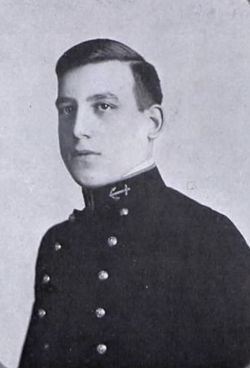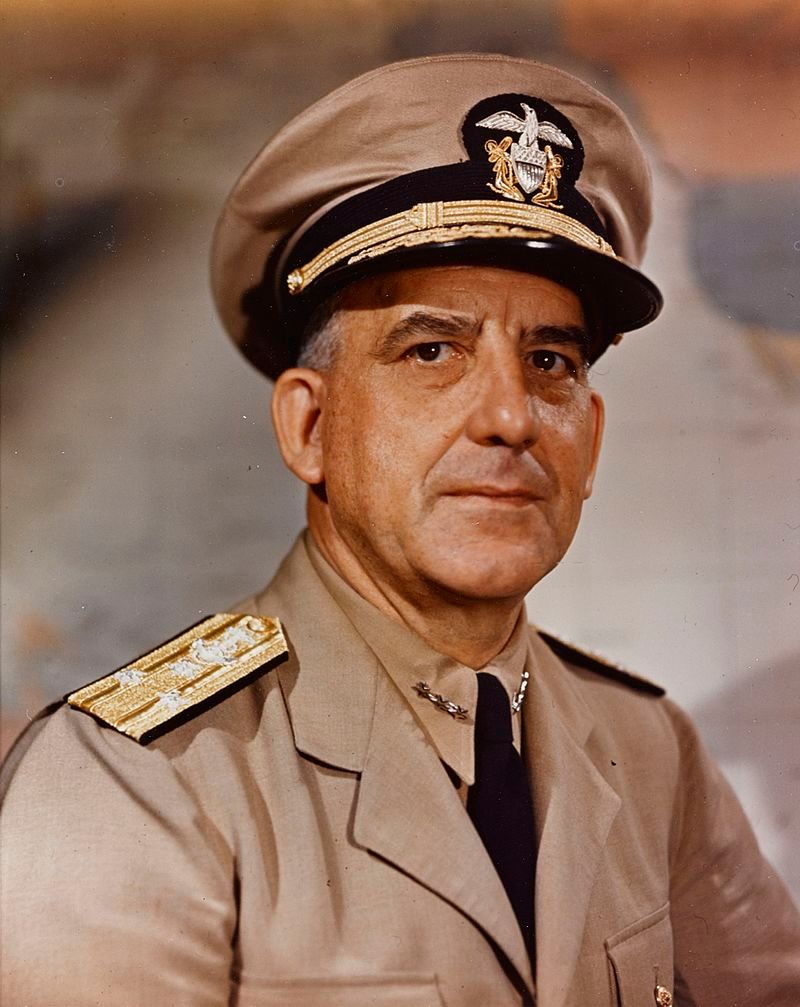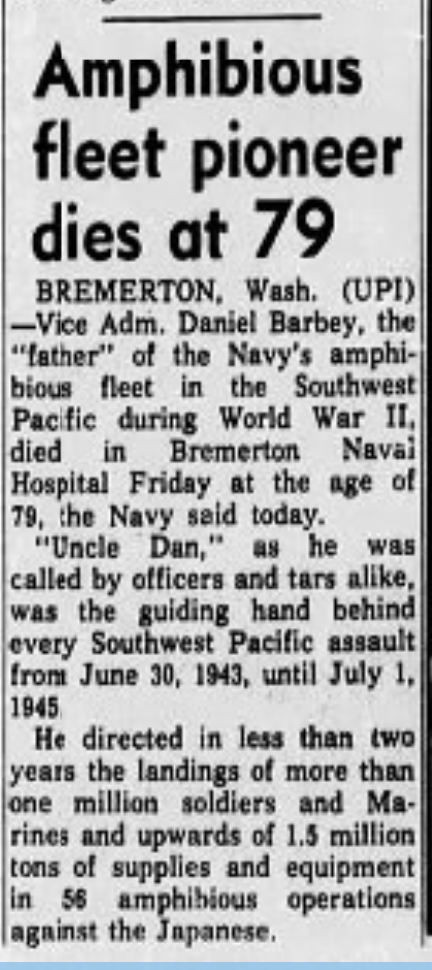Vice Admiral Daniel Edward Barbey was a top Naval strategist and diplomat who served as an officer in World War I and World War II. He was born in Portland, Oregon in 1889 and graduated from the Naval Academy in 1912. He served in the 1912 U.S. occupation of Nicaragua and in the 1915 U.S. occupation of Veracruz. In 1927 he married Katherine Graham in Portland. From 1937-1940 he was assigned to the Navy's war plans section where he became interested in the study of crude landing craft used in the second Sino-Japanese War. This ultimately led to his publication "Fleet Training Publication 167–Landing Operations Doctrine, United States Navy" in 1940, and in 1943 he assumed command of the Navy's 7th Amphibious Forces. His strategies enabled the amphibious landing of one million soldiers on islands in the South Pacific in World War II. Admiral Barbey guided 56 amphibious operations, he took personal command of more than 30 of them, and went ashore with assault forces on every major operation. He gained the nickname, "Uncle Dan, the Amphib Man". After the war, he commanded the United States Seventh Fleet and the Fourth Fleet. In addition to his military skill, he was a proven diplomat who took a keen interest in different cultures. He served 39 years in the Navy, retiring from active duty in 1951, his final military service being commandant of the 13th Naval District in Seattle. Upon retirement from the Navy, he became director of Civil Defense for the State of Washington until 1956. He died in 1969. In 1971, the Navy Destroyer "USS Barbey" named in his honor, was christened by his widow. In 1990 the USS Barbey served in the Persian Gulf with distinction.
Military Awards:
Navy Distinguished Service Medal (2)
Army Distinguished Service Medal
Legion of Merit
Commander of the Order of the British Empire
Navy Cross Citation (courtesy of contributor BarryC):
"The President of the United States of America takes pleasure in presenting the Navy Cross to Rear Admiral Daniel Edward Barbey (NSN: 0-7930), United States Navy, for extraordinary heroism and distinguished service in the line of his profession as Commander, Amphibious Force, SEVENTH Fleet, during attacks on Japanese-occupied Lae and Finschafen in New Guinea, on 4 September and 22 September 1943. With singular skill and inspiring courage, Rear Admiral Barbey personally led his forces to the beachheads under relentless air attacks and expertly directed the brilliantly executed landings which ultimately resulted in victory to our forces. The sound tactical knowledge, fearless leadership and inspiring devotion to duty displayed by Rear Admiral Barbey were in keeping with the highest traditions of the United States Naval Service."
Vice Admiral Daniel Edward Barbey was a top Naval strategist and diplomat who served as an officer in World War I and World War II. He was born in Portland, Oregon in 1889 and graduated from the Naval Academy in 1912. He served in the 1912 U.S. occupation of Nicaragua and in the 1915 U.S. occupation of Veracruz. In 1927 he married Katherine Graham in Portland. From 1937-1940 he was assigned to the Navy's war plans section where he became interested in the study of crude landing craft used in the second Sino-Japanese War. This ultimately led to his publication "Fleet Training Publication 167–Landing Operations Doctrine, United States Navy" in 1940, and in 1943 he assumed command of the Navy's 7th Amphibious Forces. His strategies enabled the amphibious landing of one million soldiers on islands in the South Pacific in World War II. Admiral Barbey guided 56 amphibious operations, he took personal command of more than 30 of them, and went ashore with assault forces on every major operation. He gained the nickname, "Uncle Dan, the Amphib Man". After the war, he commanded the United States Seventh Fleet and the Fourth Fleet. In addition to his military skill, he was a proven diplomat who took a keen interest in different cultures. He served 39 years in the Navy, retiring from active duty in 1951, his final military service being commandant of the 13th Naval District in Seattle. Upon retirement from the Navy, he became director of Civil Defense for the State of Washington until 1956. He died in 1969. In 1971, the Navy Destroyer "USS Barbey" named in his honor, was christened by his widow. In 1990 the USS Barbey served in the Persian Gulf with distinction.
Military Awards:
Navy Distinguished Service Medal (2)
Army Distinguished Service Medal
Legion of Merit
Commander of the Order of the British Empire
Navy Cross Citation (courtesy of contributor BarryC):
"The President of the United States of America takes pleasure in presenting the Navy Cross to Rear Admiral Daniel Edward Barbey (NSN: 0-7930), United States Navy, for extraordinary heroism and distinguished service in the line of his profession as Commander, Amphibious Force, SEVENTH Fleet, during attacks on Japanese-occupied Lae and Finschafen in New Guinea, on 4 September and 22 September 1943. With singular skill and inspiring courage, Rear Admiral Barbey personally led his forces to the beachheads under relentless air attacks and expertly directed the brilliantly executed landings which ultimately resulted in victory to our forces. The sound tactical knowledge, fearless leadership and inspiring devotion to duty displayed by Rear Admiral Barbey were in keeping with the highest traditions of the United States Naval Service."
Family Members
Sponsored by Ancestry
Advertisement
Explore more
Sponsored by Ancestry
Advertisement









